


Industry's First Wideband Bluetooth Low Energy sniffer with concurrent capture of Wi-Fi 802.11 1x1 a/b/g/n, raw 2.4 GHz spectrum, HCI (UART, SPI), WCI-2, logic signals, and Audio I2S.
All-in-One: concurrent capture of Bluetooth Low Energy, Wi-Fi 1x1, raw spectrum, HCI and logic, all synchronized to sub-microsecond precision
Wideband Capture: rock-solid capture of all Bluetooth Low Energy channels
Extremely Compact: pocket-sized at 7.5 x 7.5 x 1.7 cm (2.9 x 2.9 x 0.7'')
USB Powered: ultimately portable, convenient and environmentally friendly
Reprogrammable Digital Radio: support for new specifications with a simple software update, without hardware changes
Wi-Fi: debug your Wi-Fi a/b/g/n and BLE connections simultaneously, as well as coexistence
Raw 2.4 GHz Spectrum Capture: characterize the wireless environment and visualize interferences
Professional Software: use the acclaimed, widely adopted and highly flexible Ellisys multi-protocol analysis software.
All Protocols and Profiles: best-of-breed protocol decoding
Logic Analysis: visualize digital signals such as GPIOs, interrupts, debug ports, etc, concurrently and perfectly synchronized with your BLE and Wi-Fi traffic
Free Maintenance: free lifetime software updates as well as free fully-featured viewer software with unlocked hardware that can be used on any computer
Capturing wireless traffic is a very important aspect of Bluetooth debugging, but other information is equally important for understanding the big picture. The Ellisys Bluetooth Tracker sniffer supports one-click concurrent and tightly synchronized capture of:
Bluetooth Low Energy
Wi-Fi 1x1 802.11 a/b/g/n [Enterprise]
2.4 GHz Spectrum [Pro]
UART HCI (2 ports) and SPI HCI (2 ports) [Pro]
Logic signals [Pro]
Wireless Coexistence Interface 2 (WCI-2) [Enterprise]
Ellisys participates and sponsors Bluetooth UnPlugFest events, and as such, provides equipment and expertise at every event to ensure participants have the right tools at the right time. UPFs are also a good opportunity to see Ellisys sniffers in action. Feel free to register and attend our one-to-one training session and our public Debug in Action training.
Bluetooth Low Energy, Wi-Fi, and HCI protocols and profiles are displayed in an easy-to-understand, high-level procedures-oriented chronological format in their respective Overview window and fully detailed to the lowest bit/byte level in the linked Details view. All traffic is displayed in designated Overviews real-time, as capture progresses.
The user is provided a rich set of controls to easily customize any Overview, including powerful filtering and coloring capabilities designed to quickly isolate specific protocols, profiles, or communications of interest. Traffic can be presented at the highest level of abstraction and the user can drill down to show all intermediate levels, down to the most basic elements, such as packet-only views.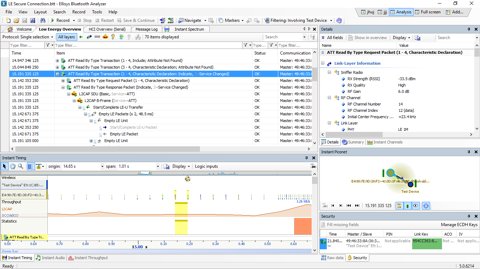
The Tracker includes an integrated Wi-Fi capture capability that allows for precision synchronization with all other wired and wireless traffic captured by the analyzer (Bluetooth Low Energy, logic signals, HCI). Wi-Fi traffic is presented in a dedicated Overview window and presented chronologically in a flexible and very configurable high-level procedures-oriented format. Wi-Fi packets are shown in the Instant Timing and Instant Spectrum windows to provide accurate and comprehensive understandings of Wi-Fi sequences, timings, as well as coexistence characterizations. A convenient Wi-Fi Security view allows for entry of passkeys. Various exports allow for display of Wi-Fi protocols in popular third-party formats.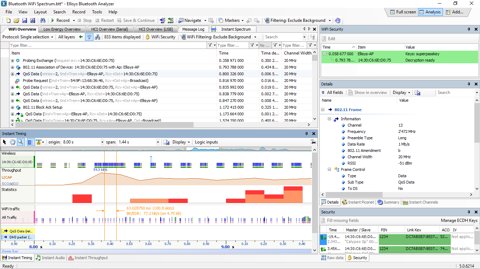
The 2.4 GHz ISM band used by Bluetooth Low Energy is quite busy. Other users of this band include Wi-Fi, LTE, ZigBee, ANT and a broad range of other proprietary and commercial technologies. These users interfere with each other and it is often necessary to have a better understanding of the wireless environment.
The Instant Spectrum display is the perfect tool for coexistence debugging, wireless characterization, or simply for visualizing the RF environment. It captures and synchronously displays all wireless packets, including the RF signatures and signal strength (RSSI) of all emitters, including Bluetooth Low Energy and Wi-Fi transmissions, and all other RF in the Bluetooth spectrum. A configurable precision of up to 1 microsecond is provided.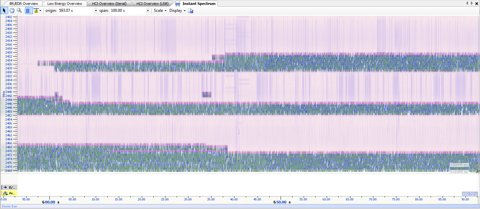
Instant Channels [Standard]
Root-causing transmission and reception issues are critical to understanding the reliability of Bluetooth Low Energy communications. The spectrum in which Bluetooth Low Energy operates is quite busy with many other RF emitters, including Wi-Fi, telephonic communications equipment, and even microwave ovens. The Instant Channels view is very useful in determining which channels are being avoided by any given link, characterizing transmission errors and retransmissions on a per-channel basis, and understanding the progression of these characteristics over time.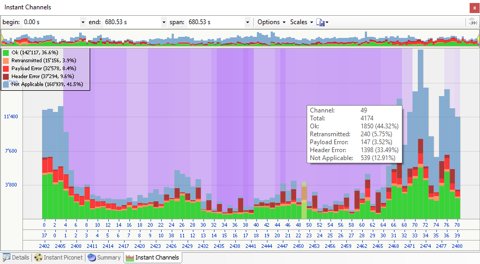
Once a capture is initiated, the user is provided with a dynamic and intuitive depiction of Bluetooth topologies as they evolve. The Instant Piconet pane displays a graphical representation of devices, piconets, and mesh network, along with connection and topology characteristics, throughput, and RSSI indications. On saved traces, the user can step through topology changes to visualize these events. 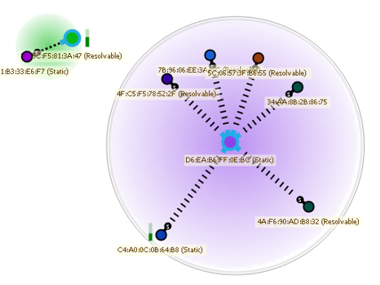
Timing issues are a primary concern to wireless developers. Low-level timing errors can cause serious application issues and can be near impossible to isolate without proper tools like the Tracker and its Instant Timing feature. The Instant Timing pane provides a unique and intuitive way to precisely understand various timing characteristics of and between Bluetooth Low Energy and Wi-Fi traffic, HCI packets, external logic signals, throughput characteristics, error and retransmission graphics, and connection events.
Bluetooth Low Energy and Wi-Fi packets are presented chronologically left to right and are uniquely color-coded per the packet’s sender. The Instant Timing pane provides various approaches for timing characterizations. Tools are provided for slot timings, two types of timing cursors, zoom and pan features, detailed packet flyovers, color-code assignments to devices, and a multitude of other powerful characterization and navigation features.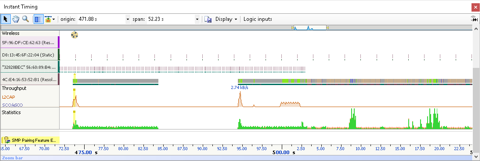
The logic analysis feature enables capture up to 16 logic signals, in synchronization with any other captured wireless and wired traffic. Any digital signal is supported, including general-purpose I/Os (GPIOs) or dedicated pins such as TX/RX Active. Another of the many applications for this feature is keeping track of a device’s power consumption in various states, by using dedicated hardware such as comparators for determining whether key thresholds are exceeded.
These signals can then be visualized with 5-nanosecond precision and compared with the other captured streams in the powerful Instant Timing view of the Ellisys software.
Wireless traffic is of course one of the most useful elements of debugging information for Bluetooth Low Energy engineers, but Host Controller Interface (HCI) traffic is an equally important complement of information for getting a clear and complete picture of the situation.
HCI is an electrical interface defined by the Bluetooth Low Energy specification for communications between the host controller and the radio. The Tracker supports synchronized capture of UART HCI and SPI HCI. All HCI traffic is captured concurrently with the wireless traffic using the same precision clock for perfect synchronization and timing analysis, and is displayed in the highly-optimized Ellisys analysis software.
HCI capture is also a very convenient feature when working with devices that implement BLE Secure Connections. The Ellisys analysis software automatically extracts any Link Key exchanged over HCI and uses it to decrypt the wireless traffic, all without any user interaction.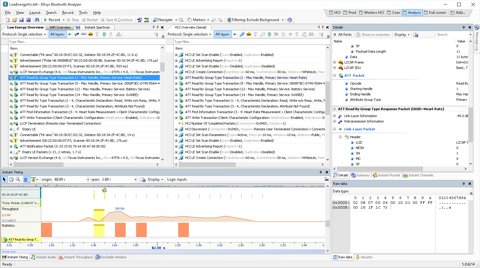
While the Tracker’s powerful protocols and profiles display is most efficient for engineers, Message Sequence Charts are usually preferred for creating reports or sharing technical information with specification experts or others not typically involved in using protocol analysis tools. The Ellisys solution is to create a Message Sequence Chart representation from a previously filtered and annotated protocols view. With this approach, engineers can include precisely the information they want, the way they want, and create a clear depiction showing exactly the information desired.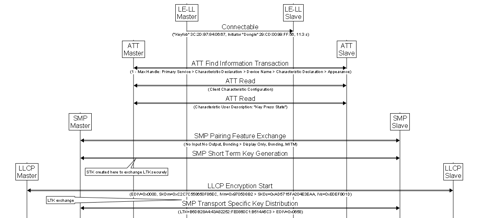
There are various user applications that require the use of the analyzer in an automated fashion, often under control of user-defined software applications performing a variety of tasks. These applications may include long-term test environments, integration of the analyzer into a mobile platform, and other usage models.
Thanks to the ease-of-use and robustness provided by the Ellisys Digital Radio, the Tracker is the perfect system for these tasks. The analyzer can be controlled with a simple yet powerful Remote Control API (Application Programming Interface) to programmatically start / stop / save captures, and extract specific captured information that can be used for various purposes, including go/no-go testing , all without any manual operation.
A unique segmentation feature works seamlessly with the API to allow for extremely long captures, segmenting captures into smaller more manageable slices while maintaining topology and contextual information from capture to capture.

Current Products:WIFI Protocol Analyzer BTR1